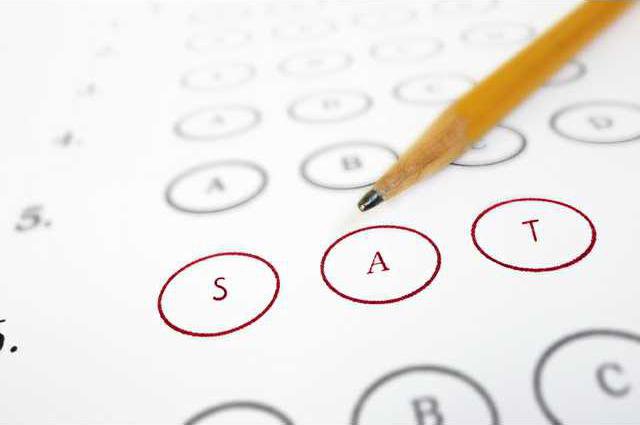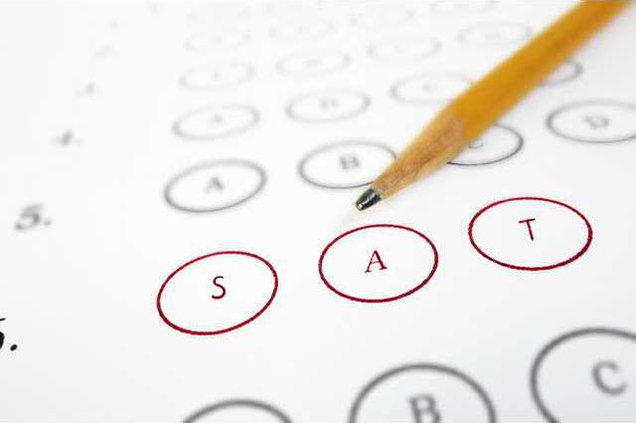The SAT, or the Scholastic Aptitude Test, has been undergoing a lot of changes.
In addition to adjustments to the content of the test, the College Board, which administers and scores the test used by colleges and universities as a measure of entrance qualifications, is now providing test preparation materials to schools.
That's a shift from the longstanding tradition of students preparing on their own.
But James S. Murphy of The Atlantic spoke with critics who worry that future SAT preparation will steal precious class time from core subjects and that College Boards outsized in-school influence will leave educators and administrators around the country with no choice but to comply with the companys new guidelines or risk having their students fall behind their peers around the country.
As Brendan Mernin of tutoring service Noodle told Murphy, The SAT is supposed to show what you got out of your schoolwork. It is not supposed to be the schoolwork.
Murphys sources may have good reason to worry. College Board, in conjunction with its revised test, announced The SAT School Day, a program to help schools incorporate SAT practice into their calendar. The program joins a comprehensive SAT-centric curriculum, called the SAT Suite of Assessments, that extends from junior high school through graduation and allows College Board to track student progress through testing.
Its bound to take time away from traditional instruction, Murphy writes.
Set to debut in the spring of next year, the redesigned test will create a robust and durable bond between assessment and instruction, according to College Boards executive summary. This includes replacing archaic vocabulary, which some critics, like Kathleen Parker of the Washington Post, think is still essential knowledge, with familiar words that can have various meanings, dependent on context. The writing section, previously mandatory, has become optional.
Scoring will change a bit, too. Students will no longer lose points for wrong answers (they previously lost a quarter point), and the test will forego its 2,400-point scale for the old 1,600-point system.
The SATs changes come amid increased competition from its main rival, the ACT, or the American College Testing exam. In 2015, 39 percent of high schoolers preferred to take the ACT, while 37 percent preferred the SAT, according to the Princeton Reviews College Hopes and Worries Survey Report.
The SAT has been, since its inception in 1926, an evaluation of aptitude, not achievement, as is elucidated in its name. The test was intended to score a students college readiness by measuring her innate intelligence rather than her ability to prepare for a four-hour exam.
But the reality is that the test has always been study-able, according to David Coleman, head of the College Board. Students able to familiarize themselves with the tests format through pricey Princeton Review or Kaplan study sessions have had an edge over students whose families could not afford prep courses and tutors.
"It is time for an admissions assessment that makes it clear that the road to success is not last-minute tricks or cramming but the learning students do over years each day, Coleman declared last year.
The updated exam, at least on paper, meets Colemans goal. Its slightly less study-able a high score depends on a grasp of the subject matters learned in school and not test-taking schemes, according to the executive summary.
And thanks to College Boards outreach efforts, the test is more accessible than ever, a huge boon for high-achieving, low-income students.
The test redesign is accompanied by study options that level the playing field between these students and their more privileged peers, says Coleman. His company has partnered with Khan Academy, popular purveyor of online instructional videos, to help bring SAT study materials to students at no cost. Its also planning to give branches of the Boys and Girls Clubs of America around the country materials to jump-start SAT preparation.
"Any student, especially lower-income students, will be able to go on to the Khan Academy resource," Sal Khan, founder of Khan Academy, told NPR. "They'll get unlimited practice, unlimited feedback, they'll get explanation and video and in text form. And if they engage on that on a regular basis and really master the concepts, I don't see any reason why they shouldn't be able to compete at a level footing.
* * *
Test your college readiness with this practice SAT exam.
In addition to adjustments to the content of the test, the College Board, which administers and scores the test used by colleges and universities as a measure of entrance qualifications, is now providing test preparation materials to schools.
That's a shift from the longstanding tradition of students preparing on their own.
But James S. Murphy of The Atlantic spoke with critics who worry that future SAT preparation will steal precious class time from core subjects and that College Boards outsized in-school influence will leave educators and administrators around the country with no choice but to comply with the companys new guidelines or risk having their students fall behind their peers around the country.
As Brendan Mernin of tutoring service Noodle told Murphy, The SAT is supposed to show what you got out of your schoolwork. It is not supposed to be the schoolwork.
Murphys sources may have good reason to worry. College Board, in conjunction with its revised test, announced The SAT School Day, a program to help schools incorporate SAT practice into their calendar. The program joins a comprehensive SAT-centric curriculum, called the SAT Suite of Assessments, that extends from junior high school through graduation and allows College Board to track student progress through testing.
Its bound to take time away from traditional instruction, Murphy writes.
Set to debut in the spring of next year, the redesigned test will create a robust and durable bond between assessment and instruction, according to College Boards executive summary. This includes replacing archaic vocabulary, which some critics, like Kathleen Parker of the Washington Post, think is still essential knowledge, with familiar words that can have various meanings, dependent on context. The writing section, previously mandatory, has become optional.
Scoring will change a bit, too. Students will no longer lose points for wrong answers (they previously lost a quarter point), and the test will forego its 2,400-point scale for the old 1,600-point system.
The SATs changes come amid increased competition from its main rival, the ACT, or the American College Testing exam. In 2015, 39 percent of high schoolers preferred to take the ACT, while 37 percent preferred the SAT, according to the Princeton Reviews College Hopes and Worries Survey Report.
The SAT has been, since its inception in 1926, an evaluation of aptitude, not achievement, as is elucidated in its name. The test was intended to score a students college readiness by measuring her innate intelligence rather than her ability to prepare for a four-hour exam.
But the reality is that the test has always been study-able, according to David Coleman, head of the College Board. Students able to familiarize themselves with the tests format through pricey Princeton Review or Kaplan study sessions have had an edge over students whose families could not afford prep courses and tutors.
"It is time for an admissions assessment that makes it clear that the road to success is not last-minute tricks or cramming but the learning students do over years each day, Coleman declared last year.
The updated exam, at least on paper, meets Colemans goal. Its slightly less study-able a high score depends on a grasp of the subject matters learned in school and not test-taking schemes, according to the executive summary.
And thanks to College Boards outreach efforts, the test is more accessible than ever, a huge boon for high-achieving, low-income students.
The test redesign is accompanied by study options that level the playing field between these students and their more privileged peers, says Coleman. His company has partnered with Khan Academy, popular purveyor of online instructional videos, to help bring SAT study materials to students at no cost. Its also planning to give branches of the Boys and Girls Clubs of America around the country materials to jump-start SAT preparation.
"Any student, especially lower-income students, will be able to go on to the Khan Academy resource," Sal Khan, founder of Khan Academy, told NPR. "They'll get unlimited practice, unlimited feedback, they'll get explanation and video and in text form. And if they engage on that on a regular basis and really master the concepts, I don't see any reason why they shouldn't be able to compete at a level footing.
* * *
Test your college readiness with this practice SAT exam.





